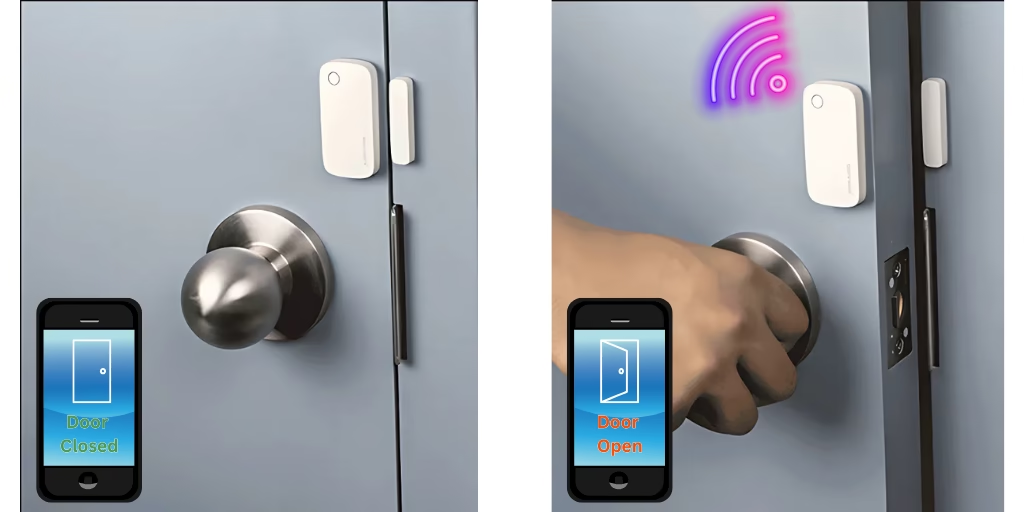Smart Door and Window Sensor Uses, Installation, and Tips
Smart door and window sensors are a key part of most smart homes. They’re cheap to buy, compact, versatile, and surprisingly powerful, these little devices are the backbone of a smart security system.
What Are Smart Door and Window Sensors
Smart door and window sensors are typically made up of two components: a magnet and a sensor. One part attaches to the door or window, and the other attaches to the frame. When the two components are separated (the door or window is opened), the contact sensor detects the change and sends a signal to your smart home hub or mobile device. When the two parts are returned together (the door or window is closed) a signal is sent with the change.
How Do They Work
Most sensors work using magnetic contact switches:
- When the door/window is closed, the magnet aligns with the sensor, completing a circuit.
- When opened, the circuit breaks, and the sensor registers this as a “triggered” event.
Some advanced models include accelerometers to detect motion or vibration.
Power
Smart contact sensors typically run on small button batteries, like the CR2032 or CR2450. Some models use larger batteries like the CR123 battery. The battery life varies depending on usage, but will typically last at least 6 months, but can last for up to 2 years, depends on usage, environment (cold conditions battery life drains quicker) and battery capacity
Popular Uses
Security
- Receive alerts when a door or window is opened.
- Integrate with alarm systems to trigger sirens or call emergency services.
Automation
- Turn on lights when a door opens.
- Adjust the thermostat when a window is opened (to prevent energy waste).
- Lock doors automatically at night if sensors detect they’re closed.
Monitoring
- Check if children opened a door unexpectedly.
- Get notifications if an elderly family member exits the house at unusual hours.
Alternative and Creative Uses
Smart sensors are versatile. Here are some unusual ways to use them:
- Fridge / Freezer Doors: Get notified if they’ve been left open.
- Mailbox Monitoring: Know when mail has arrived.
- Cabinet Protection: Monitor medicine, alcohol, or cleaning supply cabinets.
- Pet Access: Track when your cat uses a cat flap.
- Garage Door Alerts: Know when it’s opened or left open.
- Safe Monitoring: Be alerted if someone opens a home safe or lockbox.
Pros and Cons
Pros
- Easy to install – typically peel and stick or screw mounted
- Low maintenance – long battery life
- Flexible – can be used almost anywhere
- Real time alerts – via smartphone or smart home assistant
- Affordable – great starting point into smart home security
Cons
- False alarms – wind, faulty installation, or pets can trigger alerts.
- Limited range – Connection issues in large homes.
- Sticker damage – Using a sticker to install the sensor can pull off paint or wall paper when removed
Installation Tips
- Surface Preparation: Clean surfaces before sticking to ensure strong adhesion.
- Alignment Matters: The sensor and magnet must be properly aligned and close (typically the gap can’t be more than 1 cm). Most devices have some sort of mark to indicate line up position.
- Avoid Metal Surfaces: These can interfere with wireless signals.
- Distance: Make sure the sensor is in range of your smart home hub. For large homes it might be worth considering using long range sensors like the YoLink Door and Window Sensor
- Test Before Final Install: Temporarily place the sensor, test, then secure permanently.
Practical Usage Advice
- Set Schedules: Turn off alerts during expected high traffic hours.
- Integrate with Scenes: Combine sensors with smart lights and locks for routines like “Leaving Home” or “Bedtime.”
- Use Notifications Wisely: Customise which doors send alerts and when, to avoid notification overload.
- Combine with Cameras: For better security, trigger a smart camera to record when a sensor activates.
Technical Specs to Look For
When buying sensors, consider:
- Wireless Protocol: Wi-Fi or Bluetooth (for standalone) vs. Zigbee or Z-Wave (hub required).
- Integration: Compatible with Alexa, Google Home, Apple HomeKit, etc.
- Tamper Alerts: Some models notify you if the device is removed or damaged.
- Temperature / Humidity Sensors: Some include environmental monitoring.
Final Thoughts
Smart door and window sensors are an easy, affordable entry point into home automation and security. Whether you’re looking to beef up your home’s defences or find clever ways to automate everyday tasks, these sensors offer a ton of flexibility




